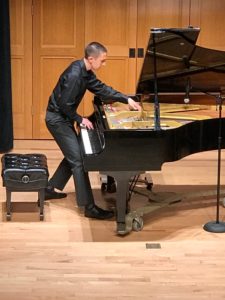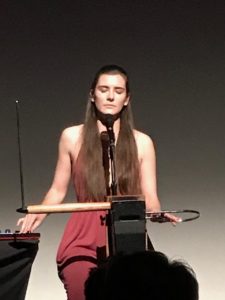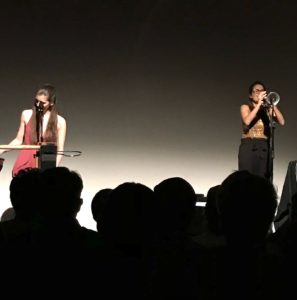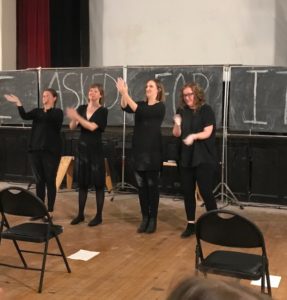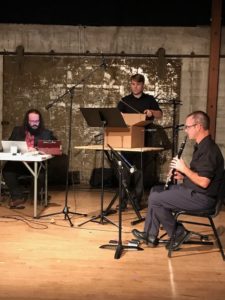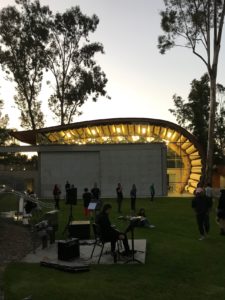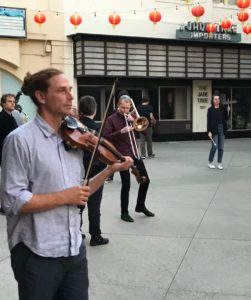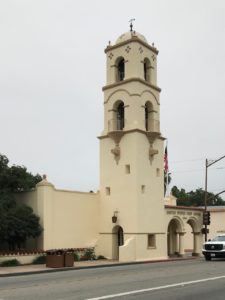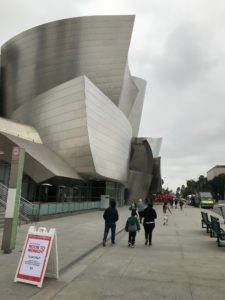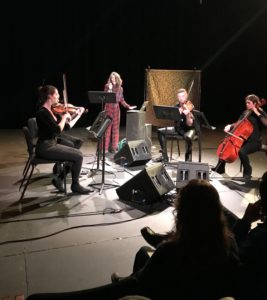 On Wednesday, December 11, 2019 REDCAT, in downtown Los Angeles, hosted the Isaura String Quartet in a concert of new music titled hum. Five works were presented by contemporary composers including two world premiers and a West Coast premiere. A fine mid-week crowd filled the REDCAT venue, braving the fierce holiday traffic.
On Wednesday, December 11, 2019 REDCAT, in downtown Los Angeles, hosted the Isaura String Quartet in a concert of new music titled hum. Five works were presented by contemporary composers including two world premiers and a West Coast premiere. A fine mid-week crowd filled the REDCAT venue, braving the fierce holiday traffic.
Darkness is Not Well Lit (2016), by Nicole Lizée, opened the concert and for this piece the quartet was seated on low risers with an floor fan stationed in front of each player. The concert notes explained that this work is “…a sonic imaging of a film noir for string quartet as seen – and heard – from the vantage point of an electric fan.” The performance space filled with the recorded roaring of a large fan at the beginning, and a series of simple phrases rose quietly from the cello and viola. A violin entered next, with a lovely sustained tone that arced above the deep chords in the lower strings. The moving fan blades in front of each player acted on the musical sounds to produce a sort of fluttery feel, especially in the sustained notes of the lower registers. The effect was both curious and beguiling, effectively connecting the playing ensemble to the fan sounds coming out of the speakers. This effect would likely have been more pronounced in a smaller venue, but Darkness is Not Well Lit is nevertheless an intriguing implementation of a surprisingly simple experimental technique.
String Quartet (2014), by Laura Steenberge followed, a piece written for the JACK Quartet and inspired by wild things: wolves, whales, crows and cuttlefish. The opening is a series of strong, sustained chords in the cello and viola that evoke a lonely sadness. The violins join in – without any pulse or beat present – to create a sort of distilled sorrow. The viola tones move up in pitch as the violins shift into a high, whimpering cry as might be heard among wolves in a lonely wood at night. After a short pause, high, thin tones are heard in the violins while the cello scratches out rough and rugged sound below. The upper strings emit a series of screeches that soon coarsen into harsher tones. A series of repeating notes in a tutti chord, that becomes darker and discordant as it lengthens, is particularly effective. Humming by the players adds to the richness of the sound and a short a cappella section finishes the piece. The playing of String Quartet is evocative and skillful, complimenting the organic eloquence of the music.
The world premiere of Quartet for the Beginning of a Time (2019), by David Rosenboom, was next, a complex and sophisticated work that manages to artfully balance earnest abstraction with settled convention. The structure of the piece is based on the relationships of a series of catenaries – curves that guide the diffuseness and clarity of various musical parameters. The composer writes that these relationships include the “…clarity of tonal reference dissolving into atonal fields and re-emerging later, clarity of perceivable pitch evolving into and out of relatively non-pitched sounds, independence versus synchronicity among players, relational simultaneities, temporal densities and speeds, and shifting complex dynamics of simple versus compound time forms and melodic shapes.”
Quartet for the Beginning of a Time opens with sustained tutti chords joined in agreeable harmony, yet with an expectant feel. A series of squeaks and chirps soon break out in the upper strings and this gradually increases until it dominates the texture in all registers. The tutti sections, when they occur, become ever more strident and seem to further the incoherence of the melodies. It is as if the music is undergoing a nervous breakdown. As the piece proceeds the dissembling becomes more intense and the higher parts break into a series of independent and rapid phrases. Pizzicato and extended techniques take over, with much rapping and knocking of the instruments. A loud snapping sound is heard from a cello string, and the ensemble pauses – marking the boundary of two catenary curve sets in the structure. The quartet resumes but the sounds are now clearly chaotic with rapping, squealing and disconnected flurries of pizzicato spraying out in all directions – it is as if the music is falling in and out of lucidity. The long flowing phrases of the opening return, but there is an undercurrent of uncertainty and instability as the piece concludes. The brilliant playing of the Isaura Quartet is a technical triumph, equal to the emotional demands of the music. Quartet for the Beginning of a Time is a remarkable and unsettling work that applies the raw power of mental disintegration directly to the emotions of the listener.
